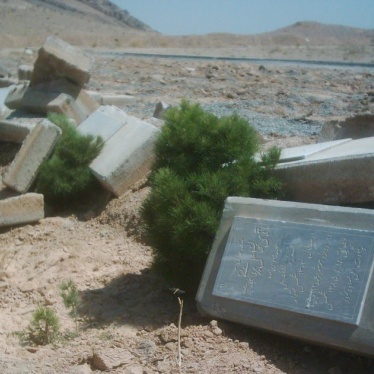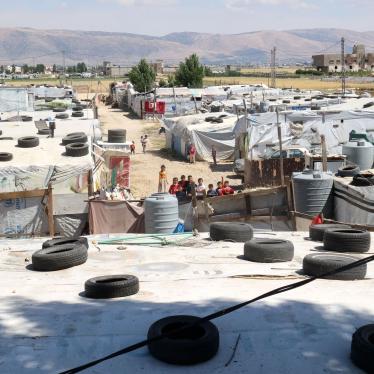Human Rights Watch mourns the passing of a close colleague and dear friend, Tim Hetherington, who was killed in Misrata, Libya, on April 20, 2011 by a mortar round while covering the armed conflict.
Hetherington was a brilliant photographer and film-maker who covered many of the world's most critical human rights stories: conflicts in Liberia, Afghanistan, Darfur, and now Libya. In every assignment, he demonstrated a remarkable sensitivity to his subjects, a tender insight into their human ordeals, and a keen sense of how visual imagery could be used to effect positive social change.
"Tim Hetherington was much more than a war reporter," said Kenneth Roth, executive director of Human Rights Watch. "He had an extraordinary talent for documenting, in compassionate and beautiful imagery, the human stories behind the headlines. We are saddened by his death and extend our deepest condolences to his family and countless friends."
Roth reiterated Human Rights Watch's call on the Libyan government to cease unlawful attacks against civilian areas in Misrata.
Hetherington lived in Monrovia, Liberia for eight years during the brutal civil war that engulfed Liberia and neighboring countries. The film that Hetherington co-directed, "Liberia: An Uncivil War," and his book, "Long Story Bit by Bit: Liberia Retold," did more than any other body of work to tell the complete story of the conflict, focusing on individual Liberians and allowing them to tell their own stories in their own words.
"Restrepo," a documentary film Hetherington made with journalist Sebastian Junger about a US combat unit in Afghanistan, was nominated for an Academy Award.
Both "Liberia: An Uncivil War," and "Restrepo," were screened at the Human Rights Watch International Film Festival in New York and London.
Human Rights Watch worked with Hetherington on a number of human rights stories over the years, including assignments to Darfur, Chad, and Sri Lanka. He was a patient and generous collaborator - one of the first professional photographers Human Rights Watch assigned in the field - and his enormous credibility helped to establish Human Rights Watch as a legitimate partner in the photography world.
In addition to his remarkable professional talents, Hetherington was a warm, lively, and thoroughly delightful friend to many staff members at Human Rights Watch.
"This is a devastating loss to many of us personally," said Roth. "But it is also a devastating loss to the human rights community. His work has raised the visibility of many of the world's forgotten conflicts. The legacy of his exceptional photographs will serve to inspire those following in his footsteps."
Tim Hetherington travelled with Human Rights Watch to Chad to investigate the spillover of violence from the neighboring conflict in Darfur, Sudan. "Darfur Bleeds" documents their findings in the village of Jawara, where 118 people were killed by Sudanese Janjaweed militia and local Chadian recruits over the course of two days in April, 2006.
Reflections from colleagues
I first met Tim in Freetown, Sierra Leone. It was 2000 and the armed conflict which pitted the RUF rebels and Sierra Leonean army continued to ravage. While most other photojournalists were fixated on documenting victims of the rebels’ signature atrocity – limb amputation – this lanky, handsome Brit set about documenting one of Africa’s, and certainly Sierra Leone’s, most forgotten and neglected populations – the blind. Many of the children in the Milton Margai School for the Blind, the object of Tim’s work, had been blinded when the rebels poured burning oil into or gouged out their eyes, in more than a few cases, because they wouldn’t stop crying.
What began as a moving photo-essay about human suffering, hope, and solidarity, grew into a relationship with the children, the teachers, and the school that lasted for years to come. While I’m sure Tim valued the World Press Photo award (portrait category) he won for his story, the pen-pal project between blind children in Sierra Leone and the UK he organized, his efforts to fundraise, and most of all the friendships he made with the children who called him “Uncle Tim” as they held his hand and jumped all over him as he tried to photograph, touched him on a far deeper level. http://www.miltonmargaischool.org/tim_hetherington.htm
Tim’s passion for West Africa took him next to Liberia. His work in that country – as a photojournalist and cameraman documenting the rebels’ frenetic march towards and final assault on Monrovia; as a member of the UN Panel of Experts; and as an author of “Long Story Bit by Bit, Liberia Retold” --characterizes the multi-faceted, holistic way Tim approached a ‘story.’ Where most journalists rocked up to cover but a chapter of a given conflict, Tim spent months, indeed years, exploring the always-complex issues which gave rise to violence; profiling the perpetrators, politicians, and profiteers that sustained it; and most of all illuminating the way ordinary lives were so tragically torn apart and forever changed by it. Indeed, I never thought of Tim as a photojournalist or author or researcher – rather as a visionary who used photos, video, memoir, and testimony to at once explain and humanize the conflicts which for most occupy a fleeting moment of our attention.
The last time we had dinner in Dakar, I was anxious to hear a few war stories from the front in Afghanistan, but he wouldn’t oblige; as humble as he was curious, he preferred asking me about HRW’s work, what I thought about the truth and reconciliation commission in Liberia, the education system in Guinea, about my daughter and our life in Senegal. I feel immense sadness for Tim's family and friends in HRW, West Africa and beyond that loved him so much, yet feel honored to have been able to work with him for so many years.
From Corinne Dufka, senior researcher, West Africa, for Human Rights Watch
We work with lots of photographers who are avid about promoting human rights, but of those I've met, Tim most deeply cared about what we do and about human rights. Whether you knew him or not, he was a genuine friend of everybody here.
James Ross, Legal and Policy Director, Human Rights Watch
In the Korengal Valley, Tim became a part of the landscape, big brother to the boys of Battle Company even as he was documenting their lives at war - their sleep, pain, dreams, goofiness, anger and innocence. Tim was constantly pushing the boundaries to convey a complete sensory experience: both his subjects' and his own. His 20-minute film Diary is a dreamscape of his inner and outer life at home and at war.
One night the soldiers set off for a distant ridge. We forded the river and began the long climb up the mountain on a goat path, stumbling over rocks and brambles. I was out of breath and struggling, and Tim took my backpack, slung it over his shoulder, and went back to filming the soldiers' arduous ascent.
About a month later, we were all caught in an ambush in the mountains during a six-day operation to infiltrate Taliban land. Insurgents had made their way up the mountainside and killed a sergeant. Tim was filming everything: the soldiers fighting back; the sergeant's best friend in tears; feet, faces, guns and dirt. The Afghan soldiers were struggling to carry the sergeant's body, but ended up dragging it through the brush. One of his friends exploded with rage. Tim switched off his camera, and helped to lift up the sergeant and give some dignity to his departure.
A soldier should not have to be dragged along the ground. It was a photo that Tim never took. And that was the thing about Tim.
Elizabeth Rubin,
Contributing writer, New York Times magazine






